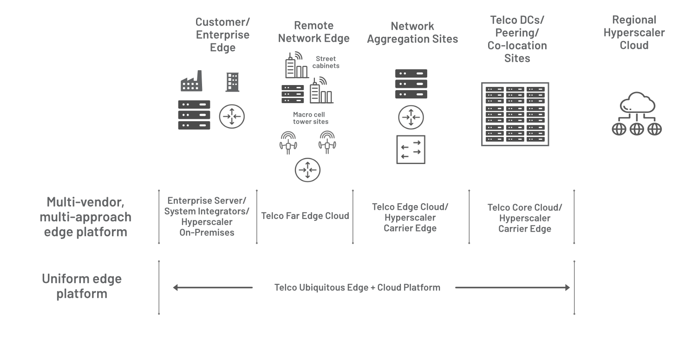Empowering Telcos with a Ubiquitous Edge Platform – Part 2
Time:2020-11-10
A Recap – the Ubiquitous Edge Platform
This is the second of two blog posts that explore the concept of a ubiquitous multi-access edge computing (MEC) platform that universally addresses edge computing needs, from customer premises to regional telco data centers. If you haven’t yet read the first blog, check it out; it will provide context for the discussion below.
We described the need for this type of MEC platform and the necessary components in the previous post. This article will explore the benefits of this platform and how it might be leveraged as part of a unique MEC strategy.
Benefits of a Unified Edge Platform
As you may recall, we described a uniform MEC platform available across all major elements in a carrier network. This platform may be embedded into an existing product, like a BBU, on a uCPE, part of the RAN equipment in a street-level cabinet, or running on a white box server as part of an NFV-powered telco cloud. This uniform platform would expose the same set of common APIs to application developers and be tied into a single orchestration system with monitoring and telemetry.
Key benefits of such a platform include:
- Flexibility and agility: with a common platform with presence in all carrier locations, telcos can offer application developers many choices as to where their workloads run, from near the cell sites to mobile aggregation locations, wireline central offices, and telco edge clouds. With a common API and platform experience, application developers can distribute components into the best location to maximize end-user experience while managing costs.
- Faster time-to-market: some carrier MEC strategies involve different platform partners in different locations, such as hyperscale cloud providers at the network edge, system integrators (SI) or software platform vendors at the enterprise edge, or network equipment providers for their telco cloud. Developers who want to leverage the telco MEC platform end up having to rebuild their applications across different development environments, often having to learn different build environments and tools. A silo-free environment allows for a higher velocity of application development and a reduced time-to-market.
- Reduced stranding of resources: the elimination of silos across multiple MEC platforms provides mobility for both data and applications. If a particular location gets overloaded, those upstream can take on additional load, albeit with increased latency. This allows for more efficient use of available resources.
- Easier integration into OSS/BSS: with a uniform MEC approach, integration with existing OSS and BSS systems will go more smoothly. Again, this will lead to a faster-time-to-market and more seamless customer and partner experience.
- Comprehensive monitoring and faster troubleshooting: with a uniform approach, monitoring and telemetry tie-ins into carriers’ existing systems will require less effort. A consistent stack across all locations is easier to troubleshoot, reducing the load on support and carrier technology.
Strategic Value with System Integrators (SIs) and Hyperscalers
Today, many carriers have concerns about partnership with hyperscalers and SIs. On their telco edge clouds, they worry that by letting hyperscalers in as partners, they’ll eventually be relegated to only providing connectivity, significantly reducing their ability to monetize. Similar concerns swirl around partnering with SIs on enterprise edge deployments. Extracting value from MEC platforms continues to be one of the major concerns at most carriers today — both wireless and wireline. By deploying a uniform MEC approach, carriers would maintain their existing relationships with the NEPs that supplied their technology platform, leaving that part of the value chain undisturbed. However, they would gain an edge computing platform that integrates well into their carrier infrastructure. The carrier would have a unified management console, to the extent that management and orchestration systems for the MEC platform (including self-service portals, etc.) are well designed and executed.

It may even be possible to host parts of hyperscale management or orchestration systems on the MEC platform or expose appropriate APIs, allowing these platforms to act as extensions of a hyperscale cloud. A similar managed services platform approach could be taken with the SIs for carrier-offered on-premises edge computing. In both scenarios, the carrier would maintain more control than in other configurations.
Real-World Examples
Instead of discussing the hypothetical, we will examine MEC customers China Telecom and China Mobile. Both are customers of ZTE (sponsor of this blog post) and have deployed the ZTE Common Edge MEC platform.
China Telecom used ZTE’s Common Edge to build a deployment model for smart manufacturing. The MEC platform was deployed at the CPE, as well as near the RAN, and in the regional cloud. By leveraging different locations, China Telecom demonstrated a 70-80% reduction in video processing delay for industrial robot control.
China Mobile leveraged the ZTE Common Edge solution to create an MEC platform for Tencent’s cloud games. As a result, Tencent reduced game-rendering latency from 120ms to 20ms, saving backhaul bandwidth costs. Further, by providing edge rendering services, Tencent could accommodate handsets with lower processing capabilities, expanding its market reach.
Getting Started with a Uniform MEC Platform
Carriers have many choices regarding their MEC solution and many potential partners and technology suppliers. In this series, we’ve described a uniform MEC approach and provided real-world examples of how this could play out. The benefits of this approach can be substantial, and we at AvidThink believe it merits consideration as part of any carrier’s MEC strategy.


